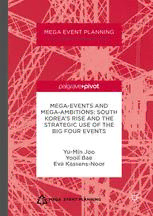
Mega-Events and Mega-Ambitions: South Korea’s Rise and the Strategic Use of the Big Four Events PDF
Preview Mega-Events and Mega-Ambitions: South Korea’s Rise and the Strategic Use of the Big Four Events
MEGA EVENT PLANNING Series Editor: Eva Kassens-Noor MEGA-EVENTS AND MEGA-AMBITIONS: SOUTH KOREA’S RISE AND THE STRATEGIC USE OF THE BIG FOUR EVENTS Yu-Min Joo Yooil Bae Eva Kassens-Noor MEGA EVENT PLANNING Mega Event Planning Series editor Eva Kassens-Noor Michigan State University East Lansing, MI, USA The Mega Event Planning Pivot series will provide a global and cross-disciplinary view into the planning for the world’s largest s porting, religious, cultural, and other transformative mega events. Examples include the Olympic Games, Soccer World Cups, Rugby championships, the Commonwealth Games, the Hajj, the World Youth Day, World Expositions, and parades. This series will critically discuss, analyze, and challenge the planning for these events in light of their legacies including the built environment, political structures, socio-economic systems, societal values, personal attitudes, and cultures. More information about this series at http://www.springer.com/series/14808 Yu-Min Joo · Yooil Bae · Eva Kassens-Noor Mega-Events and Mega-Ambitions: South Korea’s Rise and the Strategic Use of the Big Four Events Yu-Min Joo Eva Kassens-Noor Lee Kuan Yew School of Public Policy School of Planning, Design and National University of Singapore Construction & Global Urban Singapore Studies Program Singapore Michigan State University East Lansing, MI, USA Yooil Bae School of Social Sciences Singapore Management University Singapore Singapore Mega Event Planning ISBN 978-1-137-53112-4 ISBN 978-1-137-53113-1 (eBook) DOI 10.1057/978-1-137-53113-1 Library of Congress Control Number: 2017937127 © The Editor(s) (if applicable) and The Author(s) 2017 The author(s) has/have asserted their right(s) to be identified as the author(s) of this work in accordance with the Copyright, Designs and Patents Act 1988. This work is subject to copyright. All rights are solely and exclusively licensed by the Publisher, whether the whole or part of the material is concerned, specifically the rights of translation, reprinting, reuse of illustrations, recitation, broadcasting, reproduction on microfilms or in any other physical way, and transmission or information storage and retrieval, electronic adaptation, computer software, or by similar or dissimilar methodology now known or hereafter developed. The use of general descriptive names, registered names, trademarks, service marks, etc. in this publication does not imply, even in the absence of a specific statement, that such names are exempt from the relevant protective laws and regulations and therefore free for general use. The publisher, the authors and the editors are safe to assume that the advice and information in this book are believed to be true and accurate at the date of publication. Neither the publisher nor the authors or the editors give a warranty, express or implied, with respect to the material contained herein or for any errors or omissions that may have been made. The publisher remains neutral with regard to jurisdictional claims in published maps and institutional affiliations. Cover image: © nemesis2207/Fotolia.co.uk Printed on acid-free paper This Palgrave Pivot imprint is published by Springer Nature The registered company is Macmillan Publishers Ltd. The registered company address is: The Campus, 4 Crinan Street, London, N1 9XW, United Kingdom A cknowledgements We would like to thank Dr. Bokyong Seo for her valuable research assistance and Ms. Libby Morgan Beri for her help in editing the manuscript. This research was financially supported by the Lee Kuan Yew School of Public Policy, National University of Singapore. v c ontents 1 Mega-Events and Mega-Ambitions: South Korea’s Rise and the Strategic Use of the Big Four Events 1 2 1988 Summer Olympics and the Rise of South Korea and Seoul 23 3 Daejeon Expo ’93 and Paving the Way for Future Development Aspirations 47 4 2002 FIFA World Cup and the Rebranding of South Korea 69 5 PyeongChang 2018 Winter Olympics 93 6 Conclusions: The Art of Using Mega-Events for Development 117 Index 129 vii l f ist of igures Fig. 1.1 The timeline of the four mega-events and South Korea’s key political and economic events 13 Fig. 1.2 South Korea’s four mega-events and their host cities 15 Fig. 2.1 Population of Seoul (1960–1990) 30 Fig. 2.2 Changes in Seoul government’s general accounts 39 Fig. 4.1 Impact of hosting the World Cup on local fiscal autonomy 79 ix l i ist of mAges Image 2.1 Seoul Olympic Stadium 32 Image 3.1 Expo Hanbit Tower 62 Image 4.1 Seoul World Cup Stadium 80 Image 5.1 Alpensia ski jump stadium 103 xi l t ist of Ables Table 2.1 Seoul government’s development plans for the Olympics (1979) 29 Table 2.2 Investments for the Olympic-related projects and infrastructure development 33 Table 2.3 Outline of projects for the Seoul Olympic Games 34 Table 3.1 Expenses and funding sources for the Taejon Expo ’93 55 Table 4.1 Chronological chart: the 2002 World Cup bidding 72 Table 4.2 Financing shares for soccer stadiums in localities 78 Table 4.3 Sang-am New Millennium Town plan 82 xiii
